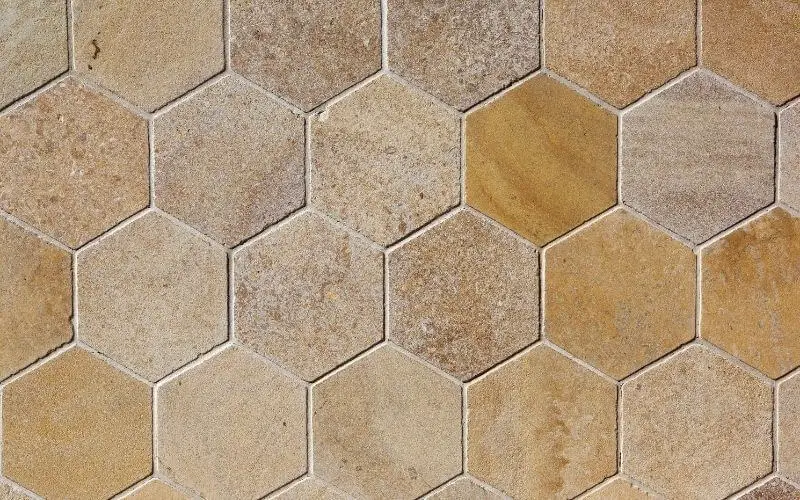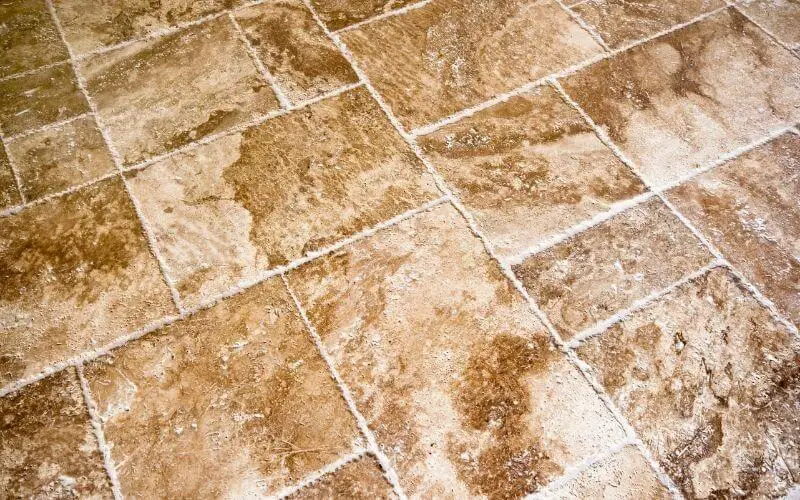Over time, your travertine floor finish may become worn and scratched from chairs, pets and shoes. This affects your floor’s appearance and makes the tiles look dull and unsightly.
This can be undone by polishing your travertine floor as it will remove the scratches and restore the floor’s luster and shine.
Steps on how to polish travertine floors includes removing the previous wax coating, steam cleaning the floor, fixing any crack or holes, taping the floor edge, polishing and finally sealing the floor.
You will need special polishing pads with a buffing machine, which will be used to sand down all the blemishes and to resurface the tiles.
Read: How to clean travertine floors
How to Polish Travertine Floors
Table of Contents
You will need;
- Shop vacuum
- Waterproof tape
- Protective plastic sheeting
- Floor stripper
- Travertine filler compound
- Mop and bucket
- Steam cleaner
- Weighted buffing machine
- Polishing powder
- Buffing pads
- Sealer
Here are the steps to polish travertine floors
Removing Previous Wax Coating
The first thing you need to do is remove the existing wax coating on the floor; you will need to deep-clean the built-up wax and dirt and use a stripper that is safe to be used on travertine to get rid of any waxy buildup on the tile surface.
You can purchase a travertine stripper from a hardware store and apply it to your floor using a clean mop.
Apply an even coating of the stripper on the floor, then mop the floor with plain water several times until you are sure that all the grime and wax are removed.
Read: How to strip and wax a gym floor
Steam Clean the Floor
With a steam cleaner, give your travertine floor a deep clean. This will help break up any residual stripper and grime left on the floor; it will also help remove light scratches and stains from the floor surface.
You can also use a steam cleaner to clean the grout between the tiles. It is imperative that you try to get your floor as clean as possible before you begin polishing.
Read: How to steam clean travertine floors
Fix Cracks, Chips, and Holes
After steam cleaning your floors, you need to make any needed repairs so as to restore the travertine floor to its original look; this you can do by fixing cracks, chips and holes on the floor.
You will need filler compounds, such as epoxy to make such repairs. If epoxy is not available, you can make use of grout the same color as the travertine as a substitute.
Apply the product according to packaging instructions, and allow it to cure for the appropriate time before moving to the next step.
Tape the Floor Edges With Plastic Sheeting
Taping off your furniture, baseboards, cabinets, and other surfaces around your floors with plastic sheeting will help to keep them protected during the polishing process.
Line the perimeter of your floor with waterproof tape and plastic sheets to prep the floor for the polishing step.
Also, take out any furniture present in the room; this is to prevent damage from the buffing machine or polishing solution.
Polish the Travertine
To polish your travertine tile, you need a weighted buffing machine. There are two primary ways to carry out the polishing process.
The first method uses various grit pads to buff the surface of the travertine until its shine is restored gradually.
You need to start by attaching a low-grit diamond pad to the bottom of the buffing machine for the first pass.
This will help to eliminate scratches, stains, and other surface etches or imperfections present on the top layer of the travertine tile.
During this step, you also need to fill holes and cracks so that the entire floor is levelled and consistent throughout.
After completing the entire floor with the first pass, repeat the process with higher-grit pads with a polishing range from 800 to 8500 till you achieve a smooth finish and a beautiful shine.
For the second polishing method, you will need polishing powder instead of multiple sanding pads.
The type of pad needed to buff the polishing powder into the floor depends on the type of polishing powder you are using.
Simply sprinkle the polishing powder onto the floor and use the buffer to work it into the tile. Repeat this process as necessary till you achieve how much shine you want the floor to have.
Keep in mind that the higher the grit of the buffer, and the more times you apply the polishing powder, the more shine you will achieve with your floors.
Read: How to make porcelain tile shine
Clean Up and Apply a Sealer
After polishing your travertine floor and have restored its original luster, you need to begin clean-up. Start by mopping the entire floor with clean water to remove any dust generated during the buffing process.
Once the floor is clean and completely dry, apply a sealer of your choice according to the manufacturer’s instructions and allow it to dry completely, this is to protect the floor surface and keep the floor looking polished for as long as possible.
Once your polishing project is completed, you can go ahead and remove the waterproof tape and protective plastic sheets on the cabinets and baseboards.
You can also return the furniture in the room and enjoy the look of your floors once again.
Read: tile
Does Travertine Tile Scratch Easily?
Travertine floors may not be as hard as granite or marble floors, but it is still a very durable stone flooring.
It can withstand wear and tear caused by foot traffic, and the appearance of crack is unlikely even with temperature extremes.
However, travertine tiles are somewhat susceptible to scratches but are less likely to be visible on honed or tumbled travertine compared to polished stone.
To avoid damaging your floor, do not drag heavy furniture across, and ensure to sweep up sand or other gritty substances that might be tracked in by pets or shoes immediately.
Your travertine floor is bound to wear and age when given enough time and exposure to the elements, but for many homeowners, that’s a plus.
In fact, many people like to install travertine floors outdoors unsealed specifically to allow weathering. Still, with regular applications of a sealer, you can keep your stone looking new and shiny.
Can You Buff Scratches Out Of Travertine?
Yes you can, you can also get scratches out of travertine or any other stone floor by getting a piece of cloth and rubbing it in olive oil or linseed oil and gently rubbing it on the travertine or stone floor.
Read: How to clean pebble stone shower floor
Conclusion
Travertine tile is a popular flooring choice, especially in well-used spaces such as the kitchen and the bathroom.
Although durable, your travertine floor may become covered with scratches due to wear and age; this is why it is important you know how to polish travertine floors so that you can restore your floor’s original appearance.
Polishing your travertine floor and buffing out scratches is the best way to restore your floor to its original luster.

